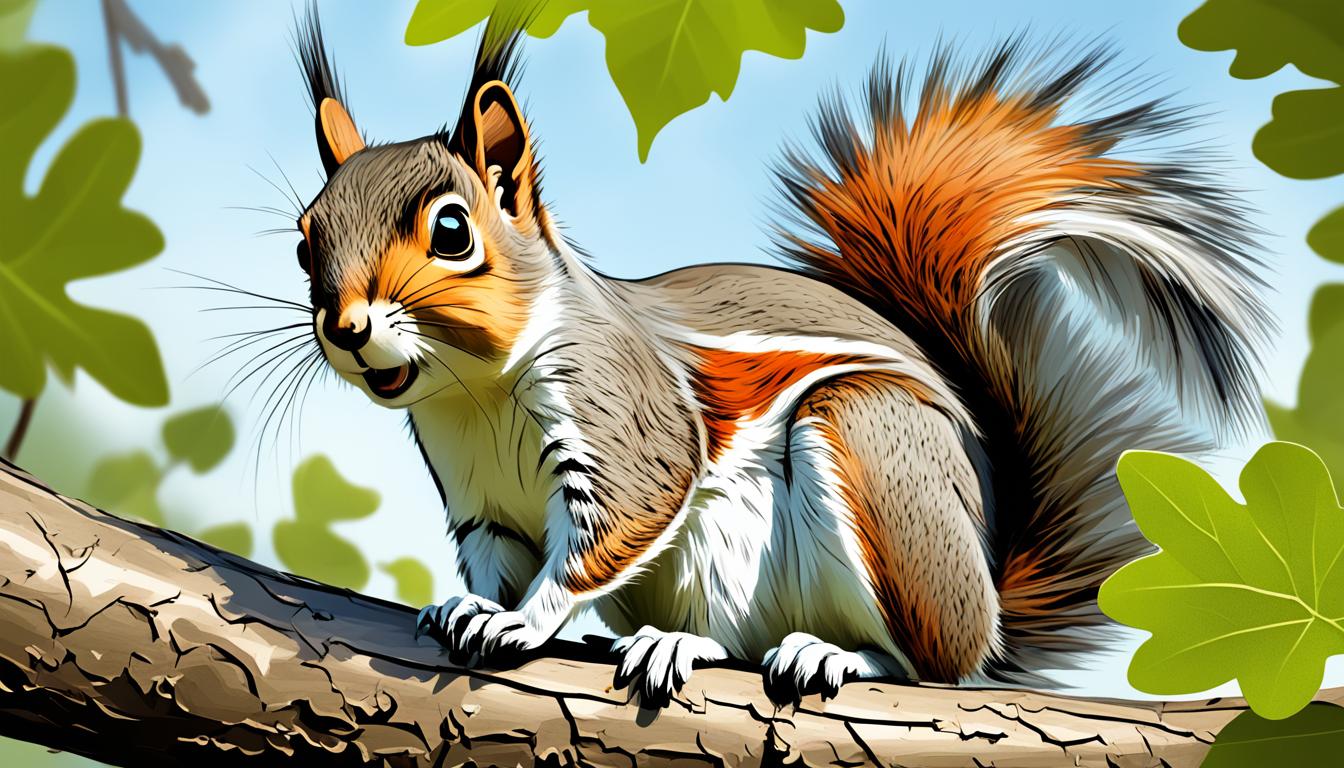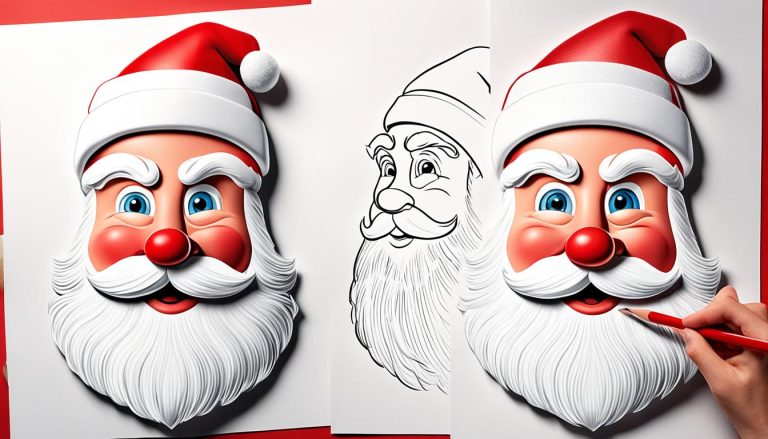How to Draw a Squirrel – Drawing Turorials and Coloring Tips
Have you ever wondered how to capture the charm and grace of a squirrel in your artwork? Drawing a squirrel may seem daunting at first, but with the right guidance and techniques, you can create stunning squirrel drawings that truly bring these furry creatures to life.
In this comprehensive guide, we will take you through the step-by-step process of drawing a squirrel, from constructing the body to adding intricate details. Whether you are a beginner or an experienced artist, this article is filled with drawing tutorials and coloring tips that will help you master the art of squirrel drawing.
Key Takeaways:
- Learn step-by-step tutorials for drawing a squirrel
- Explore different techniques for adding details and expressions to your squirrel drawings
- Discover easy squirrel drawing ideas for beginners and experienced artists
- Enhance your squirrel drawings with backgrounds and elements
- Master advanced drawing techniques for realistic and detailed squirrel art
A Quick Look at Squirrels
Squirrels are fascinating creatures that can be found in various parts of the world. There are nearly 300 different species of squirrels, including the commonly seen red squirrels and grey squirrels. Red squirrels are primarily found in Asia, while grey squirrels are found in North America.
These acrobatic animals are known for their agility and ability to leap from tree to tree. They have adapted to diverse habitats, including forests, woodlands, parks, and even urban areas. Squirrels build nests called dreys in trees and use them as shelters to rest and raise their young.
Squirrels have distinct characteristics that make them unique:
- Size: Squirrels range in size from small ground squirrels around 5-7 inches in length to larger tree squirrels that can reach up to 20 inches in length.
- Tail: One of the most recognizable features of squirrels is their bushy tail, which helps them maintain balance and serves as a rudder during jumps.
- Teeth: Squirrels have sharp incisors that continuously grow throughout their lives. They use these teeth to gnaw on nuts, seeds, and tree bark.
- Behavior: Squirrels are active during the day and spend most of their time searching for food and storing it for the winter. They are known for their hoarding behavior, burying nuts and seeds for later consumption.
To give you a better idea of the diversity of squirrels, here is a table highlighting some types of squirrels and their characteristics:
| Squirrel Species | Habitat | Characteristics |
|---|---|---|
| Red Squirrel | Asia, Europe, North America | Small size, reddish fur, tufted ears |
| Grey Squirrel | North America, Europe, UK | Medium size, grey fur, bushy tail |
| Flying Squirrel | Various regions worldwide | Flap of skin between legs for gliding, nocturnal behavior |
| Giant Squirrel | India, Southeast Asia | Larger size, colorful fur, long bushy tail |
As you can see, squirrels come in various sizes and have unique characteristics adapted to their specific habitats. In the next section, we will delve into a step-by-step tutorial for drawing a squirrel.
A Step-by-Step Tutorial for Drawing a Squirrel
Now, let’s dive into the step-by-step process of drawing a squirrel. To start, we will construct the main body of the squirrel using ovals and circles. This foundation will give us a solid framework to build upon. (squirrel drawing tutorial)
Follow these simple steps:
- Draw a large oval for the body of the squirrel. Make the oval slightly elongated to represent the natural shape of a squirrel’s body.
- Next, draw a smaller oval for the head. Position it at one end of the larger oval to create a clear distinction between the body and the head.
- Now, add two circles beneath the head for the squirrel’s front paws. These circles should overlap with the body to create a sense of depth.
- For the hind legs, draw two ovals at the opposite end of the body oval. These ovals should be slightly larger and positioned diagonally.
- Connect the front and hind legs with curved lines to complete the outline of the squirrel’s body.
- Next, add details such as the ears, eyes, and tail. The ears should be placed near the top of the head and resemble small triangles. Draw large, expressive eyes beneath the ears, and a fluffy tail at the back of the body.
Now that you have the basic structure of the squirrel, it’s time to add more realistic elements and dimensions. Pay attention to the proportions and size of each body part to ensure accuracy. (squirrel dimensions)
Remember, practice makes perfect! Don’t be afraid to make mistakes and keep refining your drawing until you’re satisfied with the result.
Here is an example of what your squirrel drawing might look like at this stage:
 |
Easy Squirrel Drawing Ideas
Are you looking for some creative inspiration for your squirrel drawings? In this section, we have compiled a variety of easy squirrel drawing ideas that will help you unleash your artistic skills. Whether you’re a beginner or an experienced artist, these ideas will spark your creativity and guide you in creating unique squirrel sketches. From cute and cartoon-like squirrels to realistic and detailed drawings, there’s something for everyone to explore.
Cute and Cartoon Squirrels
If you enjoy drawing cute and playful characters, try creating cartoon squirrels. These whimsical and adorable creatures can be brought to life with simple shapes and expressive features. Use large, round eyes, exaggerated facial expressions, and chubby cheeks to add personality to your cartoon squirrels. Remember to keep the proportions playful and experiment with vibrant colors to make your drawings stand out.
Realistic Squirrels
If you prefer a more realistic approach, challenge yourself to create detailed and lifelike squirrel drawings. Pay attention to the squirrel’s body proportions and anatomy, and focus on capturing the textures and details of their fur. You can use different shading techniques and fine lines to add depth and dimension to your drawings. Reference high-quality photographs or observe squirrels in their natural habitats to enhance the accuracy of your drawings.
Squirrel Sketching Techniques
Sketching is an excellent way to explore different styles and techniques in your squirrel drawings. With sketching, you can focus on capturing the essence of squirrels in quick, loose strokes. Experiment with different pencil grades and shading techniques to create depth and volume. Sketching allows you to loosen up your hand and create expressive and energetic squirrel drawings.
Remember, there’s no right or wrong way to draw a squirrel. Use these ideas as a starting point and let your creativity take flight. Have fun experimenting with different styles, techniques, and mediums to create your very own squirrel masterpieces.
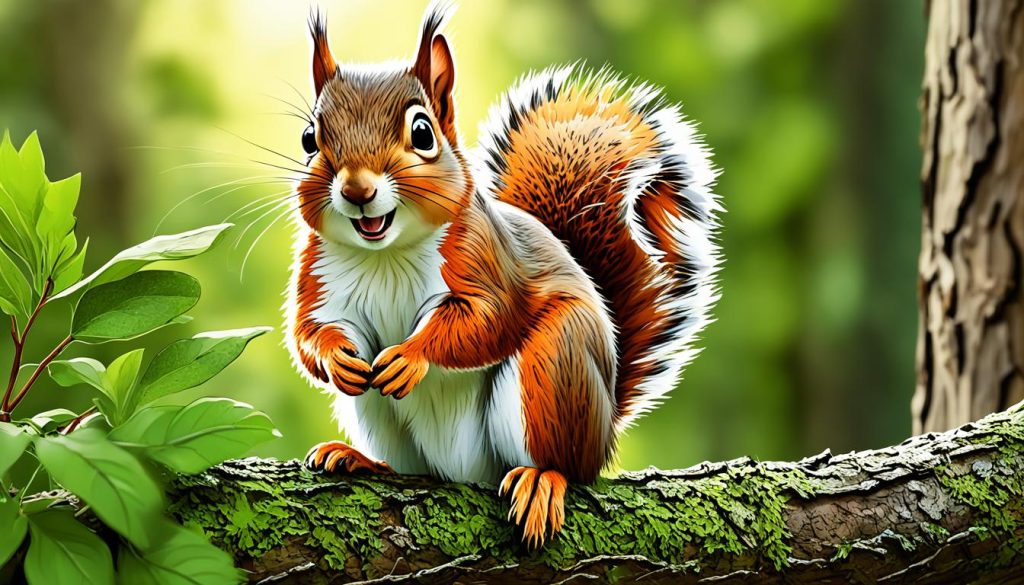
| Squirrel Drawing Idea | Description |
|---|---|
| Cute Squirrel with Acorns | Create a charming squirrel holding an acorn in its paws. Use soft lines and warm colors to emphasize the cuteness of the scene. |
| Squirrel in Motion | Draw a squirrel mid-leap or scampering up a tree trunk. Capture their nimble movements and energy in your drawing. |
| Squirrel with a Nut | Depict a squirrel with a cheeky expression, clutching a delicious nut. Pay attention to their fur texture and the nuts’ details. |
| Squirrel Family | Illustrate a joyful scene with a squirrel family gathering around a tree. Use different sizes and poses to create a sense of unity and playfulness. |
Drawing Tips and Techniques for Squirrel Art
Drawing a squirrel requires attention to detail and the use of various techniques. Whether you’re a beginner or an experienced artist, these drawing tips and techniques will help you enhance your squirrel art. From shading techniques to color choices, let’s dive into the world of squirrel drawing.
1. Shading Techniques for Squirrels
Shading plays a crucial role in bringing depth and dimension to your squirrel drawings. Here are some shading tips to consider:
- Start with light pencil strokes and gradually build up the darkness as you add shadows and contrast.
- Pay attention to the direction of light and create highlights and shadows accordingly.
- Use cross-hatching or stippling techniques to create texture and simulate the look of fur.

2. Choosing Colors for Squirrel Drawings
When it comes to coloring squirrels, you have the freedom to choose a realistic or whimsical color palette. Here are some color tips to consider:
- Observe real squirrels or reference images to determine the colors of their fur, eyes, and other features.
- Experiment with different color combinations to add vibrancy and visual interest to your drawings.
- Consider using warm earth tones like browns, tans, and oranges to capture the natural look of squirrels.
3. Adding Texture to Squirrel Fur
Texture is an important element when drawing squirrels, as it brings their fur to life. Here are some techniques to add texture to your squirrel drawings:
- Use short, quick strokes to create the appearance of individual hairs.
- Layer different tones and hues to add depth and volume to the fur.
- Blend colors and use a soft pencil or blending tool to create a smooth and realistic texture.
Remember, practice makes perfect. Don’t be afraid to experiment with different techniques and styles to develop your own unique approach to drawing squirrels.
Guided Squirrel Drawing for Kids
Drawing squirrels can be a great activity for kids to develop their artistic skills. In this section, we will provide a guided squirrel drawing specifically designed for children. The step-by-step instructions make it easy for young artists to follow along and create their own squirrel drawing. This activity can be a fun and engaging way for kids to explore their creativity and learn about squirrels.
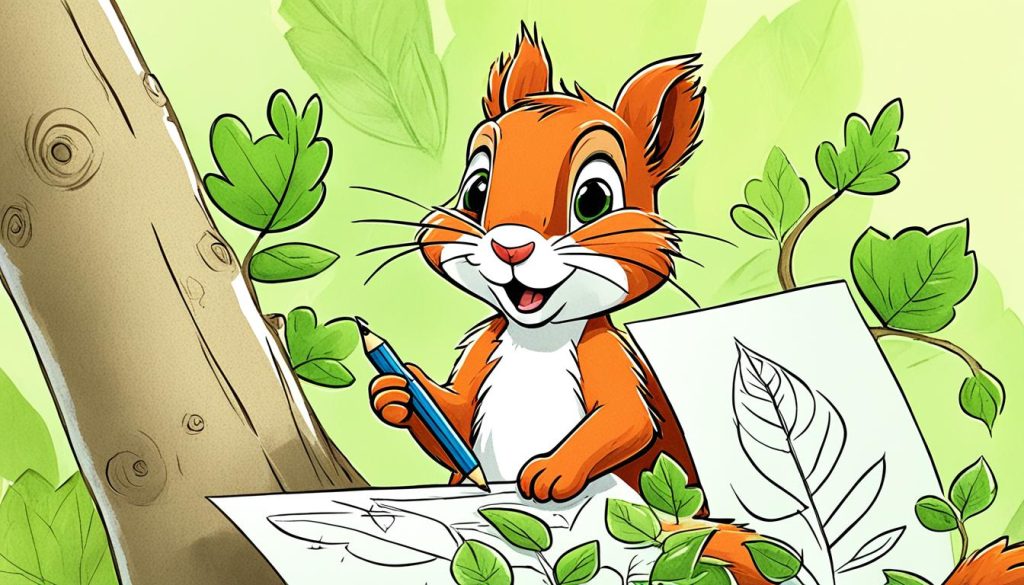
- Begin by drawing a circle for the squirrel’s head.
- Next, draw a smaller oval shape below the head for the squirrel’s body.
- Add two small circles on either side of the head for the squirrel’s ears.
- Draw a curved line inside the head to create the squirrel’s eyes and a small dot in each eye for the pupils.
- Now, draw a small triangle shape below the eyes for the squirrel’s nose.
- Add a curved line below the nose to create the squirrel’s mouth.
- Draw two slightly curved lines on either side of the body to make the squirrel’s arms.
- Below the body, draw two more curved lines to create the squirrel’s legs.
- Finally, draw a bushy tail behind the body of the squirrel.
Once you have completed the basic outline, you can add more details, such as fur texture and coloring, to make your squirrel drawing come to life. Let your imagination run wild and experiment with different colors and patterns!
Encourage children to express their creativity and have fun with their squirrel drawings. This guided squirrel drawing will help them develop their drawing skills while sparking their interest in nature and animals.
How to Draw a Squirrel in Different Poses
Squirrels are known for their lively movements and playful poses. In this section, we will explore how to capture the dynamic nature of squirrels by sketching them in different poses. By learning to draw squirrels in various positions, such as climbing a tree or holding a nut, you can bring your squirrel drawings to life and add a sense of movement to your artwork.
To begin, let’s take a look at some examples and instructions for drawing squirrels in different poses:
Pose 1: Climbing a Tree
Start by sketching the basic shape of the squirrel’s body using ovals and circles. Then, add details such as the head, ears, and limbs. Use curved lines to represent the squirrel’s tail and indicate movement. Pay attention to the position of the legs and paws, showing the squirrel gripping onto the tree trunk.
Pose 2: Holding a Nut
Begin by drawing the squirrel’s body in a relaxed standing position. Make sure to capture the curvature of the squirrel’s back and the position of its legs. Add the details of the squirrel’s head, ears, and facial features. Then, draw the squirrel’s front paws holding onto a nut, using curved lines to show the grip.
Pose 3: Leaping in the Air
Start by sketching the squirrel in a mid-leap position, with its body stretched out and legs extended. Capture the movement by using flowing lines to represent the squirrel’s fur and tail. Pay attention to the position of the limbs and show the squirrel’s paws ready to land on the ground.
Remember, these are just a few examples of squirrel poses you can experiment with. Feel free to explore different angles, positions, and movements that showcase the squirrel’s lively nature.
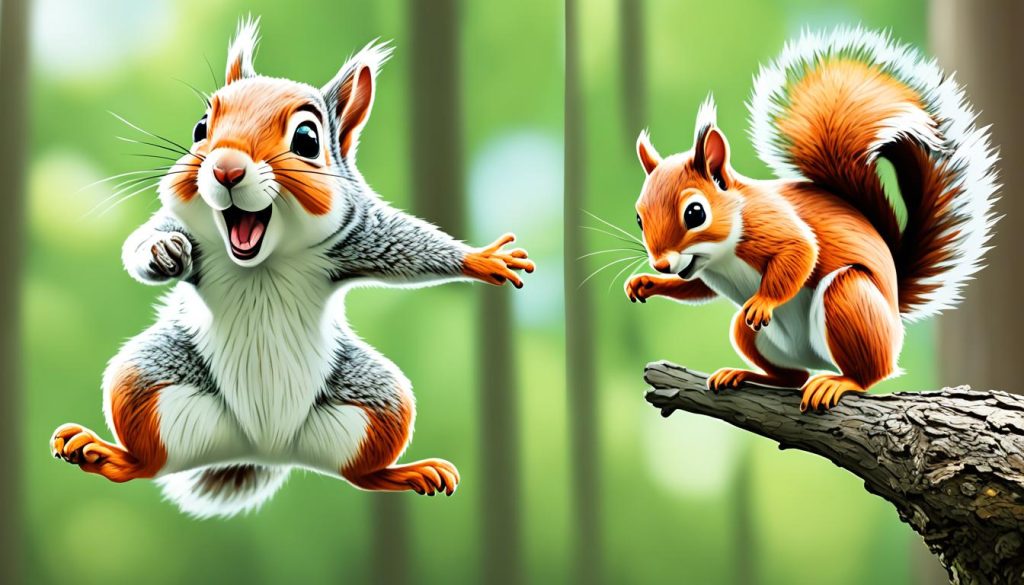
Adding Details and Expression to Your Squirrel Drawings
To truly bring your squirrel drawings to life, it’s crucial to focus on the finer details that convey expressions and emotions. By paying attention to facial features and subtle nuances, you can capture the personality and character of these captivating creatures. In this section, we will explore techniques for adding squirrel facial expressions, eye details, and other elements that enhance the emotional impact of your artwork.
1. Conveying Squirrel Facial Expressions
The facial expressions of squirrels can vary widely, from curiosity and mischief to alarm and contentment. By mastering the art of facial expressions, you can effectively communicate these emotions through your drawings. Here are some key tips to consider:
- Observe real-life squirrels or reference photographs to study their range of facial expressions.
- Focus on the position and curvature of the squirrel’s eyes, mouth, and eyebrows to depict different emotions.
- Experiment with various lines and shapes to capture expressions like happiness, surprise, and determination.
Remember, the eyes play a significant role in expressing emotions, so pay close attention to them when adding facial details.
2. Highlighting Squirrel Eye Details
The eyes are often referred to as the windows to the soul, and the same holds true for squirrel drawings. By paying attention to the details of squirrel eyes, you can add depth, life, and realism to your artwork. Here are some techniques to consider:
- Start by outlining the shape and size of the eyes, making sure they are proportionate to the squirrel’s face.
- Use shading and highlights to create depth and bring the eyes to life.
- Consider the reflection of light in the eyes to add a spark of vitality.
These eye details can significantly contribute to capturing the essence and personality of the squirrel you are drawing.
3. Capturing Squirrel Emotions
Squirrels, like humans, experience a range of emotions, including joy, fear, curiosity, and more. As an artist, your goal is to convey these emotions through your drawings. Here are some techniques to help you capture squirrel emotions:
- Study the body language of squirrels to understand how their posture and movements convey various emotions.
- Pay attention to the position and shape of the squirrel’s ears, as they can indicate different moods.
- Experiment with different angles and poses to convey specific emotions, such as a squirrel standing tall with a confident posture or a squirrel crouched down in a cautious position.
By incorporating these techniques, you can infuse your squirrel drawings with a range of emotions, making them more relatable and engaging.
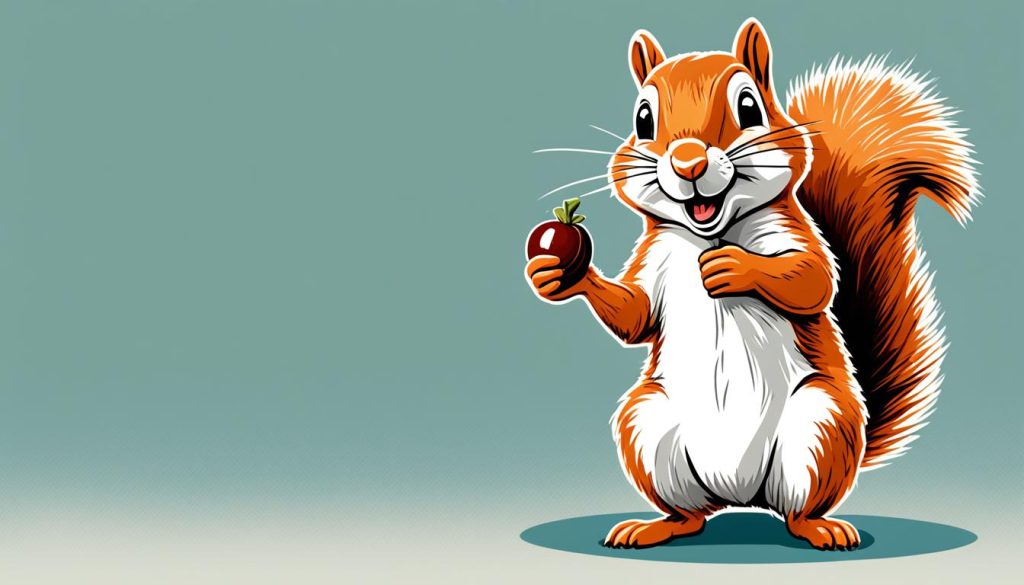
Now that we’ve explored techniques for capturing squirrel facial expressions, eye details, and emotions, it’s time to put these concepts into practice in your own artwork. Let your imagination soar as you bring your squirrel drawings to life with expressive details that evoke a sense of emotion and connection with your audience.
Enhancing Your Squirrel Drawings with Backgrounds and Elements
In order to elevate your squirrel drawings to the next level, it’s important to create realistic environments that provide context and depth. By adding backgrounds and nature elements, such as trees and grass, you can transform your artwork into captivating visual stories. In this section, we will explore various techniques and tips to enhance your squirrel drawings with these elements.
Drawing Natural Backgrounds
When drawing squirrels, it’s essential to consider their natural habitat. By carefully crafting backgrounds, you can create a realistic environment for your squirrel drawings. Here are some tips:
- Start by sketching the outline of your squirrel, leaving space for the background elements.
- Research reference images of forests, parks, or other natural settings to get inspiration for your background.
- Pay attention to the perspective and scale to ensure that the background elements align with your squirrel drawing.
- Use light, loose strokes to suggest trees, bushes, and foliage in the background.
- Add depth and dimension by layering different shades of green for the trees and various tones for the leaves.
Adding Trees and Nature Elements
Trees and other nature elements can bring your squirrel drawings to life and create a sense of realism. Here are some techniques for adding trees and other natural elements to your drawings:
- Start by sketching the basic shape of the tree trunk and branches, considering the perspective and position in relation to the squirrel.
- Add details to the tree trunk, such as bark texture and knots, to make it look more realistic.
- Use a combination of light and dark shading to create depth and volume in the tree.
- Add leaves to the branches, using small, curved strokes to mimic their texture and shape.
- Consider adding other nature elements, such as grass, flowers, or rocks, to further enhance your squirrel drawing.
Remember, the key is to create a harmonious balance between your squirrel and the background elements. By paying attention to details and practicing these techniques, you can create stunning squirrel drawings that transport viewers into the natural world.
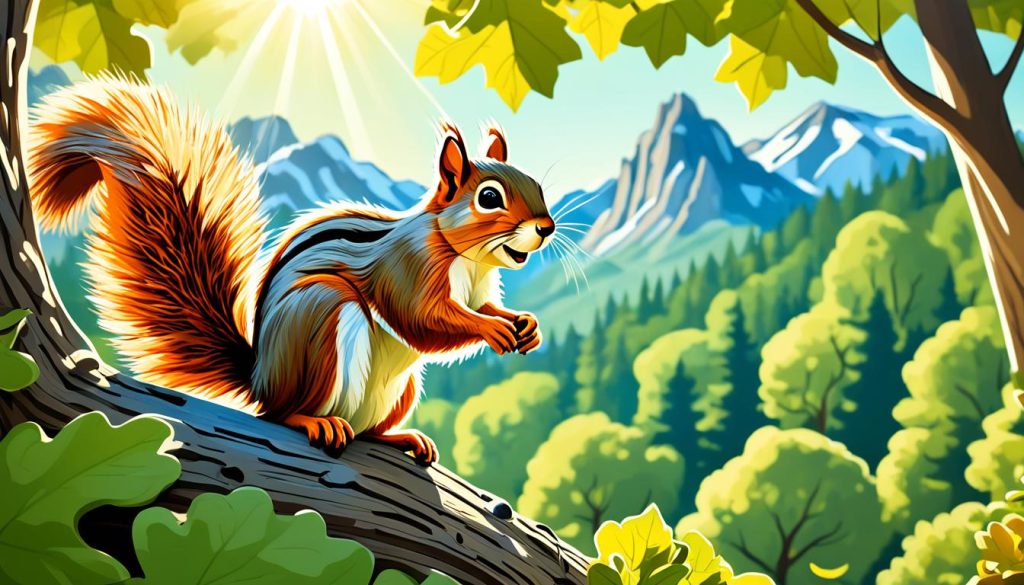
Final Thoughts
Adding backgrounds and nature elements to your squirrel drawings opens up endless possibilities for storytelling and creating realistic environments. By incorporating trees, grass, and other elements, you can bring depth and context to your artwork. Practice these techniques and experiment with different compositions to enhance your squirrel drawings and take them to new heights!
Advanced Squirrel Drawing Techniques
For experienced artists looking to challenge themselves, this section is dedicated to exploring advanced squirrel drawing techniques. By mastering these techniques, you can create realistic squirrel drawings that showcase your artistic skills and attention to detail.
To achieve a lifelike representation of a squirrel’s fur, it’s essential to focus on shading and texture techniques. Here are some key techniques to enhance the realism of your squirrel drawings:
- Layered shading: Start by establishing the base tone of the squirrel’s fur using light, even strokes. Gradually build up layers of darker shades to create depth and dimension. Pay close attention to the direction of the fur and vary your strokes accordingly for a more natural look.
- Hatching and cross-hatching: Utilize hatching and cross-hatching techniques to simulate the texture of squirrel fur. This involves drawing closely spaced parallel lines or intersecting lines to create tonal values and indicate the presence of individual hairs.
- Blending: Soften the transitions between different shades of fur by blending them together. This can be done using blending tools or by gently smudging the pencil strokes with a tortillon or cotton swab.
- Highlighting: Add highlights to certain areas of the squirrel’s fur to create a sense of shine and depth. Use an eraser or a white pencil to carefully lift or lighten certain areas, such as the top of the head or the edges of the tail.
Remember, the key to mastering these advanced techniques is practice. Take your time to observe real-life squirrels or reference high-quality photographs to study the intricate details of their fur. Don’t be afraid to experiment and refine your approach as you develop your own unique style.
Example of Layered Shading and Texture Techniques:
| Description | Image |
|---|---|
| A squirrel drawing showcasing layered shading and texture techniques | 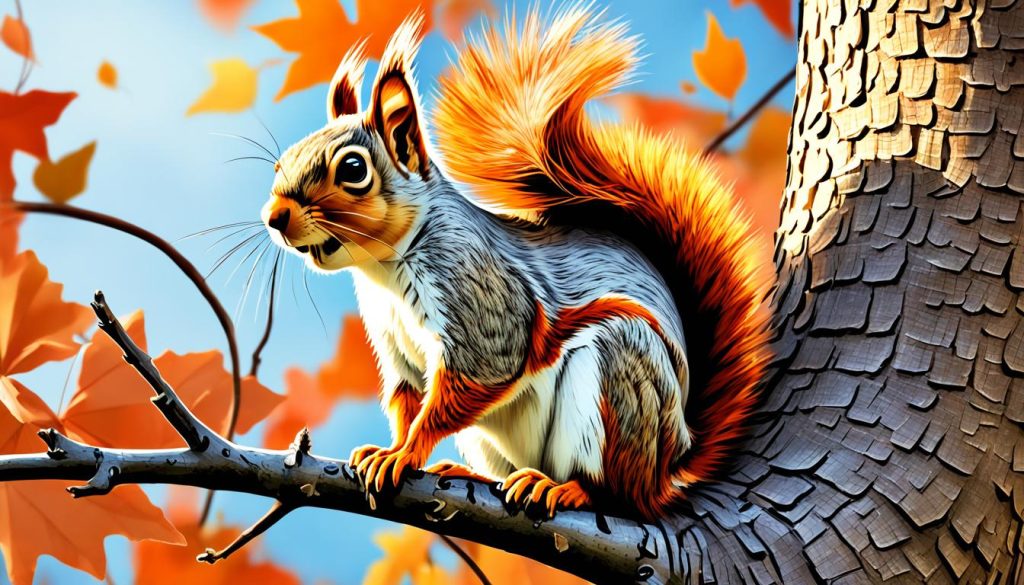 |
“The beauty of art lies in the ability to capture intricate details and bring them to life on a blank canvas. Mastering advanced squirrel drawing techniques allows you to create realistic representations of these vibrant creatures.”
Conclusion
Drawing squirrels can be a rewarding and enjoyable artistic endeavor. Throughout this article, we have provided step-by-step tutorials, tips, and techniques to help you create your own squirrel drawings. Whether you’re a beginner or an experienced artist, there are plenty of resources and ideas to inspire your creativity.
We hope this guide has sparked your interest in drawing squirrels and encouraged you to explore your artistic abilities. From constructing the body to adding details and capturing facial expressions, we have covered various aspects of squirrel drawing. With practice and patience, you can create lifelike squirrel art that showcases your skills.
Remember, drawing squirrels is about having fun and expressing your creativity. So grab your pencil, observe these intriguing creatures in nature, and let your imagination soar. Happy drawing!
